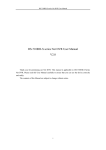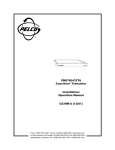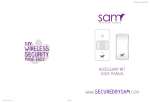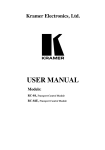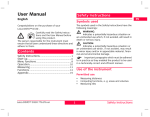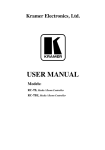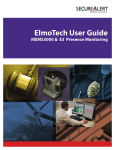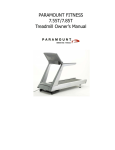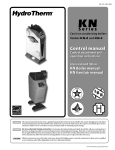Download USER MANUAL - Conference Room AV
Transcript
K R A ME R E LE CT R O N IC S L TD .
USER MANUAL
MODEL:
FC-26
Ethernet Controller
P/N: 2900-300463 Rev 1
Contents
1
Introduction
1
2
2.1
2.2
2.3
3
3.1
Getting Started
Achieving the Best Performance
Safety Instructions
Recycling Kramer Products
Overview
About the Power over Ethernet Feature
2
2
2
3
4
6
4
Defining the FC-26 Ethernet Controller
7
5
5.1
5.2
5.3
Initial Configuration and Use Overview
Configuring the FC-26 Ethernet Controller
Configuring a Virtual Port on the PC
Setting Up an Ethernet Connection on the PC
9
9
11
11
6
6.1
7
7.1
7.2
7.3
7.4
7.5
7.6
7.7
7.8
Connecting the FC-26
Connecting via Ethernet
Remote Operation via the Web Pages
Browsing the Web Pages
Connected Clients Page
Device Settings Page
Communication Page
Serial Port Settings Page
Security Page
Logs Page
About Us Page
12
13
18
18
20
21
23
24
25
27
28
8
8.1
8.2
Configuring and Maintaining the FC-26
Resetting to the Factory Default Settings
Upgrading the Firmware
29
29
29
9
9.1
9.2
10
Technical Specifications
Data Handling Performance
Example Bandwidth Calculation
Default Communication Parameters
30
31
31
32
11
11.1
11.2
11.3
11.4
Kramer Protocol 3000
Kramer Protocol 3000 – Syntax
Kramer Protocol 3000 – Command List
Kramer Protocol 3000 – Detailed Commands
Parameters
33
33
36
37
58
Figures
Figure 1: FC-26 Controlling Devices Remotely Using K-Touch 3.0 over a LAN
Figure 2: FC-26 Ethernet Controller Front Panel
Figure 3: FC-26 Ethernet Controller Rear Panel
Figure 4: Connecting the FC-26 for Initial Configuration
Figure 5: Configuring a Remote Connection
Figure 6: Connecting the FC-26 Ethernet Controller
Figure 7: Local Area Connection Properties Window
Figure 8: Internet Protocol Version 4 Properties Window
Figure 9: Internet Protocol Version 6 Properties Window
5
7
8
9
11
12
14
15
15
Contents
i
Figure 10: Internet Protocol Properties Window
Figure 11: General Info Page
Figure 12: Connected Clients Page
Figure 13: Device Settings Page
Figure 14: Communication Page
Figure 15: Serial Port Settings Page
Figure 16: Security Page
Figure 17: Security Confirmation Popup
Figure 18: Authentication Required Popup
Figure 19: Security Activated Page
Figure 20: Logs Page
Figure 21: About Us Page
ii
16
19
21
22
23
24
25
25
26
26
27
28
Contents
1
Introduction
Welcome to Kramer Electronics! Since 1981, Kramer Electronics has been
providing a world of unique, creative, and affordable solutions to the vast range of
problems that confront video, audio, presentation, and broadcasting professionals
on a daily basis. In recent years, we have redesigned and upgraded most of our
line, making the best even better!
Our 1,000-plus different models now appear in 13 groups that are clearly defined
by function: GROUP 1: Distribution Amplifiers; GROUP 2: Switchers and Routers;
GROUP 3: Control Systems; GROUP 4: Format/Standards Converters; GROUP 5:
Range Extenders and Repeaters; GROUP 6: Specialty AV Products; GROUP 7:
Scan Converters and Scalers; GROUP 8: Cables and Connectors; GROUP 9:
Room Connectivity; GROUP 10: Accessories and Rack Adapters; GROUP 11:
Sierra Video Products; GROUP 12: Digital Signage; GROUP 13: Audio, and
GROUP 14: Collaboration.
Congratulations on purchasing your Kramer FC-26 Ethernet Controller that is ideal
for use with Ethernet/RS-232 interfaces.
Introduction
1
2
Getting Started
We recommend that you:
Unpack the equipment carefully and save the original box and packaging
materials for possible future shipment
Review the contents of this user manual
Use Kramer high performance high resolution cables
i
2.1
Go to http://www.kramerelectronics.com/support/product_downloads.asp
to check for up-to-date user manuals, application programs, and to check if
firmware upgrades are available (where appropriate).
Achieving the Best Performance
To achieve the best performance:
Use only good quality connection cables (we recommend Kramer highperformance, high-resolution cables) to avoid interference, deterioration in
signal quality due to poor matching, and elevated noise levels (often
associated with low quality cables)Do not secure the cables in tight bundles
or roll the slack into tight coils
Avoid interference from neighboring electrical appliances that may adversely
influence signal quality
Position your Kramer FC-26, and away from moisture, excessive sunlight
and dust
!
2.2
Safety Instructions
!
2
This equipment is to be used only inside a building. It may only be
connected to other equipment that is installed inside a building.
Caution:
There are no operator serviceable parts inside the unit
Warning:
Use only the Kramer Electronics input power wall
adapter that is provided with the unit.
Warning:
Disconnect the power and unplug the unit from the wall
before installing
Getting Started
2.3
Recycling Kramer Products
The Waste Electrical and Electronic Equipment (WEEE) Directive 2002/96/EC
aims to reduce the amount of WEEE sent for disposal to landfill or incineration by
requiring it to be collected and recycled. To comply with the WEEE Directive,
Kramer Electronics has made arrangements with the European Advanced
Recycling Network (EARN) and will cover any costs of treatment, recycling and
recovery of waste Kramer Electronics branded equipment on arrival at the EARN
facility. For details of Kramer’s recycling arrangements in your particular country
go to our recycling pages at http://www.kramerelectronics.com/support/recycling/.
Getting Started
3
3
Overview
The FC-26 is high-performance, easy-to-use, bidirectional hardware and software
interface system for controlling RS-232 and IR-controllable devices via an Ethernet
LAN.
These Ethernet to serial controllers bridge the gap between Ethernet
infrastructures and serial communication devices by offering bidirectional Ethernet
to serial and IR conversion. All setup and maintenance of the devices is done from
built-in Web pages which are accessible using any common Web browser.
The FC-26 can receive K-Touch 3.1 Ethernet-based per IR port or per serial port
commands and converts them into IR/serial signals on the requested IR/serial
port. Responses are sent back to all Ethernet connected panels.
In particular, the FC-26:
Offers network connectivity that lets you connect a Kramer (or other) device
via its RS-232 port to an Ethernet LAN
Works in conjunction with K-Touch 3 for remote control of devices over an
Ethernet LAN via IR or serial connections, (see Figure 1)
Allows you to control up to two RS-232 devices via Ethernet from a PC,
tablet, smartphone, and so on
Allows you to control a device from multiple Ethernet points (PCs or remote
controllers), via a LAN or the Internet
Provides IR ports for device control via IR blasters/emitters
Includes Windows®-based Virtual Port software for setting up virtual ports on
a PC
4
Supports static or dynamic (DHCP) IP addressing
Can act as a PoE receiver
Has a USB port for upgrading the firmware
Supports remote firmware upgrades via a LAN
Overview
Is housed in a compact, Kramer TOOLS™ enclosure which can be mounted
side by side in a 19-inch rack using suitable rack adapters
Figure 1: FC-26 Controlling Devices Remotely Using K-Touch 3.0 over a LAN
Using K-Touch 3.0 you can design advanced room-control and automation
systems that can be operated from iOS or Android touch devices. K-Touch 3.0
can be used to perform device discovery over the network as the FC-26 is set to
be a DHCP client by default.
You can use the Kramer LAN Configurator software to discover devices that are
attached to the network, including the FC-26.
The FC-26 includes the Virtual Serial Port Manager (Kramer VSPM) for
compatibility with applications based on COM-port communication. Virtual Serial
Port Manager:
Makes the FC-26 compatible with all Windows®-based applications which
require a physical COM port. This includes all versions of K-Router and
other Kramer control applications. It lets you operate all RS-232 controllable
devices via an Ethernet LAN using their existing PC software
Allows virtual serial ports to operate like physical COM ports, that is, logical
COM ports that behave exactly like a standard hardware COM port. In
reality, it transparently reroutes the data using the TCP/IP network to the
FC-26 interface via a virtual connection which you can emulate over the
Ethernet or Internet
Allows the creation of any number of serial ports on your PC which do not
occupy any physical serial ports
Overview
5
3.1
About the Power over Ethernet Feature
Power over Ethernet passes electrical power along with data on Ethernet cabling.
This allows a single cable to provide both data connection and electrical power to
compatible devices.
6
Overview
4
Defining the FC-26 Ethernet Controller
Figure 2 defines the front panel of the FC-26.
Figure 2: FC-26 Ethernet Controller Front Panel
#
Feature
Function
1
F/W UPGRADE Mini
USB Connector
Connect to a PC to perform a firmware upgrade
2
IR IN Sensor
Sensor for IR learning
3
ETH LEDs
4
5
RS-232
LEDs
CONNECT
Lights orange when the Ethernet port is connected
DATA
Flashes green when data is transferred over the Ethernet link
TX 1
Lights green when data Is transmitted on serial port 1
RX 1
Lights red when data is received on serial port 1
TX 2
Lights green when data Is transmitted on serial port 2
RX 2
Lights red when data is received on serial port 2
6
IR OUT 1 ~ 4 LEDs
The associated LED lights green when the relevant IR port
transmits data
7
ON LED
Lights green when the unit is on
Defining the FC-26 Ethernet Controller
7
Figure 3 defines the rear panel of the FC-26.
Figure 3: FC-26 Ethernet Controller Rear Panel
#
Feature
1
RS-232 6-pin
Terminal Block
8
Function
1
Connect to the first RS-232 controlled device
2
Connect to the second RS-232 controlled device
2
IR OUTPUTS 1 ~ 4
3.5mm Mini Jacks
Connect to IR blasters/emitters using cables up to 80 m
(260ft) long
3
ETHERNET RJ-45
Connector
Connect to a PC or other controller directly or via a LAN
(see Section 6.1)
4
FACTORY RESET
Button
Press and hold while power-cycling the device to reset to
factory default parameters, (see Section 10)
5
5V DC Connector
Connect to the 5V DC power supply, center pin positive.
Not needed when the device is supplied power by a PoE
provider
Defining the FC-26 Ethernet Controller
5
Initial Configuration and Use Overview
This chapter provides an overview of the initial configuration and basic operation
of the FC-26 and comprises:
Configuring the FC-26 (see Section 5.1)
Configuring a virtual port on the PC (see Section 5.2)
Configuring an Ethernet connection on the PC (see Section 5.3)
Figure 4: Connecting the FC-26 for Initial Configuration
5.1
Configuring the FC-26 Ethernet Controller
To configure the FC-26:
1. Connect the Ethernet port on the rear panel of the FC-26 to a PC, either
directly or via a LAN, (see Section 6.1).
Initial Configuration and Use Overview
9
2. Use K-Touch 3.1 to discover the IP address of the FC-26.
You can also use K-LAN Configurator to discover the IP address of the
FC-26.
3. Using a Web browser and the IP address discovered in step 2,browse to the
General Info home page (see Figure 11).
4. Click on Device Settings to browse to the Device Settings page, (see
Figure 13).
5. Enter the time and date manually, or enter the Time server address for
automatic time and date synchronization.
6. Click Save Changes.
7. Click on Communication to browse to the Communication page, (see
Figure 14).
8. Enter the IP address, mask and gateway for static IP addressing and Click
Set.
Note: If you have changed the IP from the default setting, you must reload
the General Info home page again using the new IP address.
9. Click on Serial Ports Settings to browse to the Serial Port Settings page,
(see Figure 15).
10. Associate the required serial ports with their corresponding TCP/UDP
settings.
11. For each associated serial port, enter the serial port configuration
parameters using the drop-down lists under Serial Configuration.
12. Click Save Changes.
13. If required, click on Security to browse to the Security page.
14. Click ON to activate security.
The user name and password credentials popup appears.
15. Enter the required user name and password.
10
Initial Configuration and Use Overview
5.2
Configuring a Virtual Port on the PC
If the control application cannot work with an Ethernet driver, download the Kramer
VSPM from our Web site to set a virtual port for each local port on your
FC-26.
The Kramer VSPM software lets you emulate virtual ports which normally would
be present in the machine hardware. After setup, the virtual port lets you control
Kramer machines via your PC.
5.3
Setting Up an Ethernet Connection on the PC
If the control application can directly connect to the Ethernet driver, select the host
IP and port number according to your FC-26 configuration, as illustrated in
Figure 5.
Figure 5: Configuring a Remote Connection
Initial Configuration and Use Overview
11
6
Connecting the FC-26
i
Always switch off the power to each device before connecting it to your
FC-26. After connecting your FC-26, connect its power and then switch
on the power to each device.
Figure 6: Connecting the FC-26 Ethernet Controller
To connect the FC-26 as illustrated in the example in Figure 6:
1. Connect the device to a LAN or PC via the RJ-45 Ethernet connector.
2. Connect up to two serially controlled devices, (for example, the control port
of a switcher and a projector) to the 3-pin, RS-232 terminal blocks.
12
Connecting the FC-26
3. Connect IR emitters to the IR Outputs, (for example, two IR emitters for Bluray disk player and multimedia player control, and an IR blaster).
4. If the FC-26 is not supplied with power by a PoE provider, connect the
device to the power adapter and connect the power adapter to the mains
electricity (not shown in Figure 6).
6.1
Connecting via Ethernet
You can connect to the FC-26 via Ethernet using either of the following methods:
Directly to the PC using a crossover cable (see Section 6.1.1)
Via a network hub, switch, or router, using a straight-through cable (see
Section 6.1.2)
Note: If you want to connect via a router and your IT system is based on IPv6,
speak to your IT department for specific installation instructions.
6.1.1
Connecting the Ethernet Port Directly to a PC
You can connect the Ethernet port of the FC-26 directly to the Ethernet port on
your PC using a crossover cable with RJ-45 connectors.
i
This type of connection is recommended for identifying the FC-26
with the factory configured default IP address.
After connecting the to the Ethernet port, configure your PC as follows:
1. Click Start > Control Panel > Network and Sharing Center.
2. Click Change Adapter Settings.
3. Highlight the network adapter you want to use to connect to the device and
click Change settings of this connection.
The Local Area Connection Properties window for the selected network
adapter appears as shown in Figure 7.
Connecting the FC-26
13
Figure 7: Local Area Connection Properties Window
4. Highlight Internet Protocol Version 4 (TCP/IPv4) and click Properties.
The Internet Protocol Properties window relevant to your IT system appears
as shown in Figure 8 or Figure 9.
14
Connecting the FC-26
Figure 8: Internet Protocol Version 4 Properties Window
Figure 9: Internet Protocol Version 6 Properties Window
Connecting the FC-26
15
5. Select Use the following IP Address for static IP addressing and fill in the
details as shown in Figure 10.
For TCP/IPv4 you can use any IP address in the range 192.168.1.1 to
192.168.1.255 (excluding 192.168.1.39) that is provided by your IT
department.
Figure 10: Internet Protocol Properties Window
6. Click OK.
7. Click Close.
6.1.2
Connecting the Ethernet Port via a Network Hub or Switch
You can connect the Ethernet port of the FC-26 to the Ethernet port on a network
hub or using a straight-through cable with RJ-45 connectors.
16
Connecting the FC-26
6.1.3
Connecting to the FC-26 via RS-232 or IR
To connect to the FC-26 via RS-232:
Connect the RS-232, 3-pin, terminal block connectors on the rear panel of
the FC-26 using 3-wire cable (pin TX to pin 2, RX to pin 3, and G to pin 5) to
the RS-232 9-pin D-sub port on the devices to be controlled
To connect to the FC-26 via IR either:
Connect an IR blaster to one of the IR Outputs and place it within 4m to 8m
(13 to 26ft) and in line-of-sight of the device to be controlled
—OR—
Connect an IR emitter cable to one of the IR Outputs and stick the emitter to
the IR sensor on the device to be controlled
Connecting the FC-26
17
7
Remote Operation via the Web Pages
The embedded Web pages can be used to remotely operate the FC-26 using a
Web browser and an Ethernet connection.
Before attempting to connect:
7.1
Perform the procedures in Section 6.1.
Ensure that your browser is supported (see Section 9)
Browsing the Web Pages
To browse the Web pages:
1. Use K-Touch 3.1 to discover the IP address of the FC-26.
You can also use Kramer LAN Configurator (available for download from
http://www.kramerelectronics.com) to discover the IP address of the FC-26.
2. Open your Internet browser. Type the IP address of the device (see
Section 10) in the Address bar of your browser.
The Loading page appears followed shortly by the General Info page shown in
Figure 11.
The General Info page displays the following:
Model Name
Firmware version
Device serial number
Web page version
At the bottom left hand side of all pages there are Load/Save Configuration
buttons. These allow you to save the current configuration and load any pre-saved
configurations.
18
Remote Operation via the Web Pages
Figure 11: General Info Page
7.1.1
Loading and Saving Configurations
Loading and saving configurations can be performed using the buttons at the
bottom left-hand side of the screen irrespective of which page is displayed.
To load a configuration:
1. Click Load.
The Explorer window opens.
2. Browse to the required file.
3. Select the required file and click Open.
The device is configured according to the saved preset.
Remote Operation via the Web Pages
19
To save the current configuration:
1. Configure the device as required.
2. Click Save.
The Save File window opens.
3. Browse to the required location to which to save the file.
4. Enter the required name for the saved preset.
5. Click OK.
The current configuration is saved.
Note: When using Chrome, the file is automatically saved in the Downloads folder.
7.2
Connected Clients Page
The Connected Clients page allows you to view the following details of any client
devices connected via Ethernet to the FC-26:
20
IP address
The port it is connected to
Method of connection
Whether or not Send Replies is enabled for the port
Remote Operation via the Web Pages
Figure 12: Connected Clients Page
7.3
Device Settings Page
The Device Settings page allows you to view the model name and time server
status. You can also modify the following fields:
Device name
Device time, date, and time zone
Use a timeserver to set the time and date automatically using a (if the device
is connected to the Internet), including the Time Zone and daylight savings
time
Remote Operation via the Web Pages
21
Figure 13: Device Settings Page
The FC-26 has a built-in clock that can synchronize with a Time Server if required.
To enable Time Server synchronization:
1. Browse to the Device Settings page by clicking Device Settings.
The Device Settings page is displayed as shown in Figure 13.
2. Click the Use Time Server ON button.
3. Enter the IP address of the Time Server.
4. Enter the time of day at which the FC-26 should synchronize with the Time
Server.
5. Click Save Changes.
22
Remote Operation via the Web Pages
7.4
Communication Page
The communication page allows you to:
Turn DHCP for the device on and off
Edit the IP settings for static IP addressing
Note: The default IP address setting for the device is DHCP.
Figure 14: Communication Page
After modifying any of the IP settings, click Set to save the changes.
Remote Operation via the Web Pages
23
7.5
Serial Port Settings Page
The Serial Port Settings page allows you to:
Set the following Ethernet parameters for each Ethernet port:
Select TCP or UDP
IP port label
TCP keep-alive time
Set the following serial parameters for each serial port:
Parity
Data bits
Baud rate
Stop bits
Select whether or not to send replies on the port to the new client
Figure 15: Serial Port Settings Page
24
Remote Operation via the Web Pages
7.6
Security Page
The Security page allows you to turn logon authentication on or off.
Figure 16: Security Page
When security is on, access to the Web pages is granted only on submission of a
valid user and password. For default logon credentials see Section 10.
To activate Web page security:
1. On the Security page, click ON.
The confirmation popup is displayed as shown in Figure 17.
Figure 17: Security Confirmation Popup
Remote Operation via the Web Pages
25
2. Click OK.
The Authentication Required popup is displayed as shown in Figure 18.
Figure 18: Authentication Required Popup
3. Enter the default username and password.
4. Click OK.
5. Wait until the Web pages have reloaded. Click the Security page button.
The page show in Figure 19 is displayed.
Figure 19: Security Activated Page
26
Remote Operation via the Web Pages
6. If required, click OFF to turn security off, or change the password and click
Change.
7.7
Logs Page
The Logs page allows you to:
View current logs
Configure the logs
Filter the logs
Figure 20: Logs Page
The display may not update automatically. Click Refresh to update the display.
Use the Log Filter check-boxes to select which events to display from the log. Use
the Log Config check-boxes to select which events are recorded.
Remote Operation via the Web Pages
27
7.8
About Us Page
The About Us page displays the Web page version and the Kramer company
details.
Figure 21: About Us Page
28
Remote Operation via the Web Pages
8
Configuring and Maintaining the FC-26
8.1
Resetting to the Factory Default Settings
To reset the device to its factory default settings:
1. Turn off the power to the device.
2. Press and hold the Reset button on the front panel.
3. Turn on the power to the device while holding down the Reset button for a
few seconds.
4. Release the button.
The device is reset to the factory default settings.
8.2
Upgrading the Firmware
For instructions on upgrading the firmware see the “Kramer K-Upload User
Manual”.
Configuring and Maintaining the FC-26
29
9
Technical Specifications
OUTPUTS:
4 IR on 3.5mm mini jacks
PORTS:
2 RS-232 serial on 3-pin terminal blocks
1 Ethernet on an RJ-45 connector
1 USB on a mini USB connector for programming
SUPPORTED SERIAL PORT
BAUD RATES:
1200, 2400, 4800, 9600, 19200, 38400, 57600, 15200bps
RS-232 COMMUNICATION:
Transparent up to 115200bps
IR EMITTER CABLE RANGE:
80m (260ft)
SUPPORTED IR FREQUENCIES:
20kHz to 1.2MHz
MAXIMUM DATA HANDLING OF
DEVICE:
Up to 150kbps (summed on all ports, see Section 9.1)
SUPPORTED WEB BROWSERS:
Windows 7 and higher:
Internet Explorer (32/64 bit) version 11
Firefox version 30
Chrome version 35
MAC:
Chrome version 35
Firefox version 27
Safari version 7
Android OS:
iOS:
Chrome version 35
Chrome version 35
Safari version 7
POWER CONSUMPTION:
5V DC, 230mA
OPERATING TEMPERATURE:
0° to +40°C (32° to 104°F)
STORAGE TEMPERATURE:
–40° to +70°C (–40° to 158°F)
HUMIDITY:
10% to 90%, RHL non-condensing
COOLING:
Convection
ENCLOSURE TYPE:
Aluminium
RACK MOUNT:
With optional rack adapter
DIMENSIONS:
12cm x 7.5cm x 2.44cm
(4.72” x 2.95” x 0.96”) W, D, H
PRODUCT WEIGHT:
0.182kg (0.4lbs) approx.
SHIPPING WEIGHT:
0.43kg (0.95lbs) approx.
VIBRATION:
ISTA 1A in carton (International Safe Transit Association)
SAFETY REGULATORY
COMPLIANCE:
CE
ENVIRONMENTAL REGULATORY
COMPLIANCE:
Complies with appropriate requirements of RoHs and
WEEE
INCLUDED ACCESSORIES:
Power adapter, IR Cable C-A35M/IRE-10
OPTIONS:
19“ Rack adapter RK-3T
IR Cables—C-A35M/2IRE-10, C-A35M/IRR-3,
C-AS35M/AS35F-50, CA35M/IRE-10
Bulk cable for serial control—BC-1T-300M
Specifications are subject to change without notice at http://www.kramerelectronics.com
30
Technical Specifications
9.1
Data Handling Performance
The FC-26 is designed to support mainly AV-relevant RS-232 communication.
These devices have overall data bandwidth limits which should be high enough in
most AV installations to support the required communication bandwidth.
In extremely demanding cases, we recommend that you take into account the
bandwidth limitations.
The total sustained data bandwidth that each device can handle for all ports
simultaneously is 150kbps.
9.2
Example Bandwidth Calculation
The FC-26 has two serial ports. Each serial port can support up to:
150kbps / 2 = 75kbps
If each protocol commands is 100 bytes, (that is, 800 bits), you can safely send
and receive a minimum of 96 commands per second on each serial port. This is
shown using the following calculation:
(150kbps * 1024) / 800 bits / 2 = 96
The same calculation applies to all devices. A similar calculation applies when
fewer ports are used at the same time where a higher bandwidth per port can be
achieved.
In critical applications requiring a lossless data transfer, we recommend that
communication on all the other ports is stopped when making a long file transfer
(for example, when performing a firmware upgrade via one of the serial ports).
Technical Specifications
31
10
Default Communication Parameters
RS-232
Protocol 3000
Baud Rate:
115200
Data Bits:
8
Stop Bits:
1
Parity:
None
Ethernet
DHCP/static IP Addressing:
DHCP
Maximum Simultaneous
Connections:
40
Default Logon Authentication
Web Page Access
32
User name:
Admin
Password:
Admin
Default Communication Parameters
11
Kramer Protocol 3000
The FC-26 can be operated using serial commands from a PC, remote controller
or touch screen using the Kramer Protocol 3000.
This section describes:
Kramer Protocol 3000 syntax (see Section 11.1)
Kramer Protocol 3000 commands (see Section 11.2)
11.1
Kramer Protocol 3000 – Syntax
11.1.1
Host Message Format
Start
Address
(optional)
Body
Delimiter
#
Destination_id@
Message
CR
11.1.1.1
Simple Command
Command string with only one command without addressing:
Start
Body
Delimiter
#
Command SP Parameter_1,Parameter_2,…
CR
11.1.1.2
Command String
Formal syntax with commands concatenation and addressing:
Start
Address
Body
Delimiter
#
Destination_id@
Command_1
Parameter1_1,Parameter1_2,…|
Command_2
Parameter2_1,Parameter2_2,…|
Command_3
Parameter3_1,Parameter3_2,…|…
CR
11.1.2
Device Message Format
Start
Address
(optional)
Body
delimiter
~
Sender_id@
Message
CR LF
11.1.2.1
Device Long Response
Echoing command:
Start
Address
(optional)
Body
Delimiter
~
Sender_id@
Command SP [Param1 ,Param2 …] result
CR LF
Kramer Protocol 3000
33
CR = Carriage return (ASCII 13 = 0x0D)
LF = Line feed (ASCII 10 = 0x0A)
SP = Space (ASCII 32 = 0x20)
11.1.3
Command Terms
Command
A sequence of ASCII letters ('A'-'Z', 'a'-'z' and '-').
Command and parameters must be separated by at least one space.
Parameters
A sequence of alphanumeric ASCII characters ('0'-'9','A'-'Z','a'-'z' and some special
characters for specific commands). Parameters are separated by commas.
Message string
Every command entered as part of a message string begins with a message
starting character and ends with a message closing character.
Note: A string can contain more than one command. Commands are separated by
a pipe ( '|' ) character.
Message starting character
'#' – For host command/query
'~' – For device response
Device address (Optional, for K-NET)
K-NET Device ID followed by '@'
Query sign
'?' follows some commands to define a query request.
Message closing character
CR – For host messages; carriage return (ASCII 13)
CRLF – For device messages; carriage return (ASCII 13) + line-feed (ASCII 10)
Command chain separator character
When a message string contains more than one command, a pipe ( '|' ) character
separates each command.
34
Kramer Protocol 3000
Spaces between parameters or command terms are ignored.
11.1.4
Entering Commands
You can directly enter all commands using a terminal with ASCII communications
software, such as HyperTerminal, Hercules, etc. Connect the terminal to the serial
or Ethernet port on the Kramer device. To enter CR press the Enter key.
( LF is also sent but is ignored by command parser).
For commands sent from some non-Kramer controllers like Crestron, some
characters require special coding (such as, /X##). Refer to the controller manual.
11.1.5
Command Forms
Some commands have short name syntax in addition to long name syntax to allow
faster typing. The response is always in long syntax.
11.1.6
Chaining Commands
Multiple commands can be chained in the same string. Each command is
delimited by a pipe character (“|”). When chaining commands, enter the message
starting character and the message closing character only once, at the
beginning of the string and at the end.
Commands in the string do not execute until the closing character is entered.
A separate response is sent for every command in the chain.
11.1.7
Maximum String Length
64 characters
Kramer Protocol 3000
35
11.2
36
Kramer Protocol 3000 – Command List
Command
Description
#
Protocol handshaking
BUILD-DATE?
Read device build date
DEL
Deletes a file
DIR
List files
ETH-PORT
Sets protocol port
FACTORY
Restart the machine with the default
FORMAT
Format the file system
FS-FREE?
Print free file space
GET
Get file content
HELP
List of commands
IR-SND
Send IR command to port
IR-STOP
Stop IR command to port
LOGIN
Set/get protocol permission
LOGOUT
Demotes the terminal security level to minimum
LOG_LEVEL?
Gets current logging level
MACH-NUM
Set device ID
MODEL?
Read device model
NAME
Set/get device (DNS) name
NAME-RST
Reset device name to default
NET-DHCP
Set/get DHCP mode
NET-GATE
Set/get gateway IP
NET-IP
Set/get device IP address
NET-MAC?
Get the MAC address
NET-MASK
Set/get the device subnet mask
PASS
Set/get the password for login level
PROT-VER?
Get protocol version
RESET
Reset device
SECUR
Set/get current security state
SN?
Get device serial number
TIME
Set/get the time
TIME-LOC
Set/get local time offset from UTC/GMT
TIME-SRV
Set/get time synchronization from server
UART
Set/get a port serial parameters
VERSION?
Get firmware version number
Kramer Protocol 3000
11.3
Kramer Protocol 3000 – Detailed Commands
This section lists the detailed commands applicable to the FC-26.
Command - #
Command Type - System-mandatory
Command Name
Permission
Transparency
Set:
#
End User
Public
Get:
-
-
-
Description
Syntax
Set:
Protocol handshaking
#␍
Get:
-
-
Response
~nn@␠OK␍␊
Parameters
Response triggers
Notes
Use to validate the Protocol 3000 connection and get the machine number
Command - BUILD-DATE?
Command Name
Command Type - System-mandatory
Permission
Transparency
Set:
-
-
-
Get:
BUILD-DATE?
End User
Public
Description
Syntax
Set:
Read device build date
#BUILD-DATE␍
Get:
-
-
Response
~nn@BUILD-DATE␠date␠time␍␊
Parameters
date - Format: YYYY/MM/DD where YYYY = Year, MM = Month, DD = Day
time - Format: hh:mm:ss where hh = hours, mm = minutes, ss = seconds
Response triggers
Notes
Kramer Protocol 3000
37
Command - DEL
Command Type - File System
Command Name
Permission
Transparency
Set:
DEL
Administrator
Public
Get:
-
-
-
Description
Set:
Syntax
Delete file
#DEL␠file_name␍
Get:
Response
~nn@DEL␠file_name␠OK ␍␊
Parameters
file_name - name of file to delete (file names are case-sensitive)
Response Triggers
Notes
Command - DIR
Command Name
Command Type - File System
Permission
Transparency
Set:
DIR
Administrator
Public
Get:
-
-
-
Description
Syntax
Set:
List files in device
#DIR␍
Get:
-
-
Response
Multi Line:
~nn@DIR␍␊
file_name TAB file_size␠bytes,␠ ID:␠file_id␍␊
TABfree_size␠bytes.␍␊
Parameters
file_name - name of file
file_size - file size in bytes. A file can take more space on device memory
file_id - internal ID for file in file system
free_size - free space in bytes in device file system
Response Triggers
Notes
38
Kramer Protocol 3000
Command - ETH-PORT
Command Type - Communication
Command Name
Permission
Transparency
Set:
ETH-PORT
Administrator
Public
Get:
ETH-PORT?
End User
Public
Description
Syntax
Set:
Set Ethernet port protocol
#ETH-PORT␠portType, ETHPort ␍
Get:
Get Ethernet port protocol
#ETH-PORT?␠portType ␍
Response
~nn@ ETH-PORT␠portType, ETHPort, portNum␍␊
Parameters
portType - TCP/UDP
ETHPort - TCP/UDP port number
Response Triggers
Notes
Command - FACTORY
Command Name
Command Type - System-mandatory
Permission
Transparency
Set:
FACTORY
End User
Public
Get:
-
-
-
Description
Syntax
Set:
Reset device to factory defaults
configuration
#FACTORY␍
Get:
-
-
Response
~nn@BUILD-DATE␠date␠time␍␊
Parameters
Response triggers
Notes
This command deletes all user data from the device. The deletion can take some time
Kramer Protocol 3000
39
Command - FORMAT
Command Name
Command Type - File System
Permission
Transparency
Set:
FORMAT
Administrator
Public
Get:
-
-
-
Description
Syntax
Set:
Format file system
#FORMAT␍
Get:
-
-
Response
~nn@FORMAT␠OK␍␊
Parameters
Response Triggers
Notes
Response could take some time (seconds) until formatting completes
Command - FS-FREE?
Command Name
Command Type - File System
Permission
Transparency
Set:
-
-
-
Get:
FS-FREE?
Administrator
Public
Description
Syntax
Set:
-
-
Get:
Get file system free space
#FS-FREE?␍
Response
~nn@FS_FREE␠free_size␍␊
Parameters
free_size - free size in device file system in bytes
Response Triggers
Notes
40
Kramer Protocol 3000
Command - GET
Command Name
Command Type - File System
Permission
Transparency
Set:
-
-
-
Get:
GET
Administrator
Public
Description
Syntax
Set:
-
-
Get:
Get file
#GET␠file_name␍
Response
Multi-line:
~nn@GET␠file_name, file_size␠READY ␍␊
contents
~nn@GET␠file_name␠OK ␍␊
Parameters
file_name - name of file to get contents
contents - byte stream of file contents
file_size - size of file (device sends it in response to give user a chance to get ready)
Response Triggers
Notes
Kramer Protocol 3000
41
Command - HELP
Command Name
Command Type - System-mandatory
Permission
Transparency
Set:
-
-
-
Get:
HELP
End User
Public
Description
Syntax
Set:
-
-
Get:
Get command list or help for specific
command
2 options:
1. #HELP␍
2. #HELP␠command_name␍
Response
1. Multi-line: ~nn@Device available protocol 3000 commands:␍␊command,␠command…␍␊
To get help for command use: HELP (COMMAND_NAME)␍␊
2. Multi-line: ~nn@HELP␠command:␍␊description␍␊USAGE:usage ␍␊
Parameters
Response triggers
Notes
42
Kramer Protocol 3000
Command – IR-SND
Command Type - IR
Command Name
Permission
Transparency
Set:
IR-SND
End User
Public
Get:
-
-
-
Description
Syntax
Set:
Send IR command to port
Get:
-
#IR-SND␠PortNum,Cmdid,CmdName,Repeat,
TotalPackages,PackageNum,ProntoCmdDat ␍
-
Response
~nn@IR-SND␠PortNum,Cmdid,CmdName,Status␍␊
Parameters
Port_Num – [1..4] IR port transmitting the command. ‘*’ broadcasts to all ports
Cmd_id – serial number of command for flow control and response commands from device
CommandName – a string, the alias of the IR command. The controlling device is responsible for sending
the correct name
Repeat – number of times the IR command is transmitted (limited to 50; repeats > 50 are truncated to 50)
Total_packages – number of messages the original command was divided into, default = 1
Package_num – chunk serial number (only valid when Chnk_Num >1)
Pronto command – Pronto format command (in HEX format, no leading zeros, no ‘0x’ prefix)
Status – 0=no error (see Section 11.4.3)
Response Triggers
Notes
Kramer Protocol 3000
43
Command – IR-STOP
Command Name
Command Type - IR
Permission
Transparency
Set:
IR-STOP
End User
Public
Get:
-
-
-
Description
Syntax
Set:
Send IR stop command to port
#IR-STOP␠PortNum,Cmdid,CmdName␍
Get:
-
-
Response
~nn@IR-STOP␠PortNum,Cmdid,CmdName,Status␍␊
Parameters
Port_Num – [1..4] IR port transmitting the command. ‘*’ broadcasts to all ports
Cmd_id – serial number of command for flow control and response commands from device
CommandName – a string, the alias of the IR command. The controlling device is responsible for sending
the correct name
Status – 0=no error (see Section 11.4.3)
Response Triggers
Notes
44
Kramer Protocol 3000
Command - LOGIN
Command Type - Authentication
Command Name
Permission
Transparency
Set:
LOGIN
Not Secure
Public
Get:
LOGIN?
Not Secure
Public
Description
Syntax
Set:
Set protocol permission
#LOGIN␠login_level, password␍
Get:
Get current protocol permission level
#LOGIN?␍
Response
Set: ~nn@LOGIN␠login_level,password␠OK␍␊
or
~nn@LOGIN␠ERR␠004␍␊ (if bad password entered)
Get: ~nn@LOGIN␠login_level␍␊
Parameters
login_level - level of permissions required (End User or Admin)
password - predefined password (by PASS command). Default password is an empty string
Response triggers
Notes
For devices that support security, LOGIN allows to the user to run commands with an End User or
Administrator permission level
In each device, some connections can be logged in to different levels and some do not work with security at
all
Connection may logout after timeout
The permission system works only if security is enabled with the “SECUR” command
Kramer Protocol 3000
45
Command - LOGOUT
Command Type - Authentication
Command Name
Permission
Transparency
Set:
LOGOUT
Not Secure
Public
Get:
-
-
-
Description
Syntax
Set:
Cancel current permission level
#LOGOUT␍
Get:
-
-
Response
~nn@LOGOUT␠OK␍␊
Parameters
Response triggers
Notes
Logs out from End User or Administrator permission levels to Not Secure
Command - MACH-NUM
Command Name
Command Type - System
Permission
Transparency
Set:
MACH-NUM
End User
Public
Get:
-
-
-
Description
Syntax
Set:
Set machine number
#MACH-NUM␠machine_number␍
Get:
-
-
Response
~nn@MACH-NUM␠machine_numberOK␍␊
Parameters
machine_number - new device machine number
Response Triggers
Notes
Some devices do not set the new machine number until the device is restarted
Some devices can change the machine number only from DIP-switches
46
Kramer Protocol 3000
Command - NAME
Command Type - System (Ethernet)
Command Name
Permission
Transparency
Set:
NAME
Administrator
Public
Get:
NAME?
End User
Public
Description
Syntax
Set:
Set machine (DNS) name
#NAME␠machine_name␍
Get:
Get machine (DNS) name
#NAME?␍
Response
Set: ~nn@NAME␠machine_name␠OK␍␊
Get: ~nn@NAME?␠machine_name␍␊
Parameters
machine_name - String of up to 14 alpha-numeric chars (can include hyphen, not at the beginning or end)
Response Triggers
Notes
The machine name is not the same as the model name. The machine name is used to identify a specific
machine or a network in use (with DNS feature on)
Command - MODEL?
Command Name
Command Type - System-mandatory
Permission
Transparency
Set:
-
-
-
Get:
MODEL?
End User
Public
Description
Syntax
Set:
-
-
Get:
Get device model
#MODEL?␍
Response
~nn@MODEL␠model_name␍␊
Parameters
model_name - String of up to 19 printable ASCII chars
Response triggers
Notes
Kramer Protocol 3000
47
Command - NAME
Command Type - System (Ethernet)
Command Name
Permission
Transparency
Set:
NAME
Administrator
Public
Get:
NAME?
End User
Public
Description
Syntax
Set:
Set machine (DNS) name
#NAME␠machine_name␍
Get:
Get machine (DNS) name
#NAME?␍
Response
Set: ~nn@NAME␠machine_name␠OK␍␊
Get: ~nn@NAME?␠machine_name␍␊
Parameters
machine_name - String of up to 14 alpha-numeric chars (can include hyphen, not at the beginning or end)
Response triggers
Notes
The machine name is not the same as the model name. The machine name is used to identify a specific
machine or a network in use (with DNS feature on)
Command - NAME-RST
Command Name
Command Type - System (Ethernet)
Permission
Transparency
Set:
NAME-RST
Administrator
Public
Get:
-
-
-
Description
Syntax
Set:
Reset machine (DNS) name to
factory default
#NAME-RST␍
Get:
-
-
Response
~nn@NAME-RST␠OK␍␊
Parameters
Response Triggers
Notes
Factory default of machine (DNS) name is “KRAMER_” + 4 last digits of device serial number
48
Kramer Protocol 3000
Command - NET-DHCP
Command Type - Communication
Command Name
Permission
Transparency
Set:
NET-DHCP
Administrator
Public
Get:
NET-DHCP?
End User
Public
Description
Syntax
Set:
Set DHCP mode
#NET-DHCP␠mode␍
Get:
Get DHCP mode
#NET-DHCP?␍
Response
Set: ~nn@ NET-DHCP␠mode␠OK␍␊
Get: ~nn@ NET-DHCP␠mode ␍␊
Parameters
mode - 0 - Do not use DHCP. Use the IP set by the factory or using the IP set command
1 - Try to use DHCP. If unavailable, use IP as above
Response triggers
Notes
Connecting Ethernet to devices with DHCP may take more time in some networks
To connect with a randomly assigned IP by DHCP, specify the device DNS name (if available) using the
command “NAME”. You can also get an assigned IP by direct connection to USB or RS-232 protocol port if
available
For proper settings consult your network administrator
Kramer Protocol 3000
49
Command - NET-GATE
Command Name
Command Type - Communication
Permission
Transparency
Set:
NET-GATE
Administrator
Public
Get:
NET-GATE?
End User
Public
Description
Syntax
Set:
Set Gateway IP
#NET-GATE␠ ip_address ␍
Get:
Get Gateway IP
#NET-GATE?␍
Response
Set: ~nn@ NET-GATE␠ip_address␠OK␍␊
Get: ~nn@ NET-GATE␠ip_address␍␊
Parameters
ip_address - format: xxx.xxx.xxx.xxx
Response triggers
Notes
A network gateway connects the device via another network and maybe over the Internet. Be careful of
security problems. For proper settings consult your network administrator
Command - NET-IP
Command Name
Command Type - Communication
Permission
Transparency
Set:
NET-IP
Administrator
Public
Get:
NET-IP?
End User
Public
Description
Syntax
Set:
Set device IP address
#NET-IP␠ ip_address ␍
Get:
Get device IP address
#NET-IP?␍
Response
Set: ~nn@ NET-IP␠ip_address␠OK␍␊
Get: ~nn@ NET-IP␠ip_address␍␊
Parameters
ip_address - format: xxx.xxx.xxx.xxx
Response triggers
Notes
For proper settings consult your network administrator
50
Kramer Protocol 3000
Command - NET-MAC?
Command Type - Communication
Command Name
Permission
Transparency
Set:
-
-
-
Get:
NET-MAC?
End User
Public
Description
Syntax
Set:
Get:
Get MAC address
#NET-MAC?␍
Response
~nn@NET-MAC␠mac_address␍␊
Parameters
mac_address - Unique MAC address. Format: XX-XX-XX-XX-XX-XX where X is hex digit
Response triggers
Notes
Command - NET-MASK
Command Name
Command Type - Communication
Permission
Transparency
Set:
NET-MASK
Administrator
Public
Get:
NET-MASK?
End User
Public
Description
Syntax
Set:
Set device subnet mask
#NET-MASK␠net_mask␍
Get:
Get device subnet mask
#NET-MASK?␍
Response
Set: ~nn@NET-MASK␠net_mask␠OK␍␊
Get: ~nn@NET-MASK␠net_mask␍␊
Parameters
net_mask - format: xxx.xxx.xxx.xxx
Response triggers
The subnet mask limits the Ethernet connection within the local network
For proper settings consult your network administrator
Notes
Kramer Protocol 3000
51
Command - PASS
Command Type - Authentication
Command Name
Permission
Transparency
Set:
PASS
Administrator
Public
Get:
PASS?
Administrator
Public
Description
Syntax
Set:
Set password for login level
#PASS␠login_level, password␍
Get:
Get password for login level
#PASS?␠login_level␍
Response
~nn@PASS␠login_level, password␠OK ␍␊
Parameters
login_level - level of login to set (End User or Administrator).
password - password for the login_level. Up to 15 printable ASCII chars
Response triggers
Notes
The default password is an empty string
Command - PROT-VER?
Command Name
Command Type - System-mandatory
Permission
Transparency
Set:
-
-
-
Get:
PROT-VER?
End User
Public
Description
Syntax
Set:
-
-
Get:
Get protocol version
#PROT-VER?␍
Response
~nn@PROT-VER␠3000:version␍␊
Parameters
Version - XX.XX where X is a decimal digit
Response triggers
Notes
52
Kramer Protocol 3000
Command - RESET
Command Name
Command Type - System-mandatory
Permission
Transparency
Set:
RESET
Administrator
Public
Get:
-
-
-
Description
Syntax
Set:
Reset device
#RESET␍
Get:
-
-
Response
~nn@RESET␠OK␍␊
Parameters
Response triggers
Notes
To avoid locking the port due to a USB bug in Windows, disconnect USB connections immediately after
running this command. If the port was locked, disconnect and reconnect the cable to reopen the port.
Command - SECUR
Command Name
Command Type - Authentication
Permission
Transparency
Set:
SECUR
Administrator
Public
Get:
SECUR?
Not Secure
Public
Description
Syntax
Set:
Set security
#SECUR␠security_mode␍
Get:
Get current security state
#SECUR?␍
Response
Set: ~nn@SECUR␠security_mode␠OK ␍␊
Get: ~nn@SECUR␠security_mode ␍␊
Parameters
security_mode – 1/ON - enables security, 0/OFF - disables security
Response triggers
Notes
The permission system works only if security is enabled with the “SECUR” command
Kramer Protocol 3000
53
Command - SN?
Command Name
Command Type - System-mandatory
Permission
Transparency
Set:
-
-
-
Get:
SN?
End User
Public
Description
Syntax
Set:
-
-
Get:
Get serial number
#SN?␍
Response
~nn@SN␠serial_number␍␊
Parameters
serial_number - 11 decimal digits, factory assigned
Response triggers
Notes
For new products with 14 digit serial numbers, use only the last 11 digits
Command - TIME
Command Name
Command Type - System
Permission
Transparency
Set:
TIME
Administrator
Public
Get:
TIME?
End User
Public
Description
Syntax
Set:
Set device time and date
#TIME␠day_of_week,date,time␍
Get:
Get device time and date
#TIME?␍
Response
~nn@TIME␠day_of_week, date, time␠OK␍␊
Parameters
day_of_week - one of {SUN,MON,TUE,WED,THU,FRI,SAT}
date - Format: DD-MM-YYYY.
time - Format: hh:mm:ss
Response triggers
Notes
The year must be 4 digits
The device does not validate the day of week from the date
Time format - 24 hours
Date format - Day, Month, Year
54
Kramer Protocol 3000
Command - TIME-LOC
Command Type - System
Command Name
Permission
Transparency
Set:
TIME-LOC
End User
Public
Get:
TIME-LOC?
End User
Public
Description
Syntax
Set:
Set local time offset from UTC/GMT
#TIME-LOC␠UTC_off,DayLight␍
Get:
Get local time offset from UTC/GMT
#TIME-LOC?␍
Response
~nn@ TIME-LOC␠UTC_off,DayLight ␍␊
Parameters
UTC_off - Offset of device time from UTC/GMT (without daylight time correction)
DayLight - 0 - no daylight saving time, 1 - daylight saving time
Response triggers
Notes
If the time server is configured, device time calculates by adding UTC_off to UTC time (that it got from the
time server) + 1 hour if daylight savings time is in effect
TIME command sets the device time without considering these settings
Kramer Protocol 3000
55
Command - TIME-SRV
Command Name
Command Type - System
Permission
Transparency
Set:
TIME-SRV
End User
Public
Get:
TIME-SRV?
End User
Public
Description
Syntax
Set:
Set time synchronization from
server
#TIME-SRV␠mode, srv_ip, sync_hour␍
Get:
Get time synchronization settings
#TIME-SRV?␍
Response
For Set: ~nn@TIME-SRV␠mode,srv_ip,sync_hour␍␊
For Get: ~nn@TIME-SRV␠mode,srv_ip,server_status,sync_hour␍␊
Parameters
Mode - 0 - disabled, 1 - enabled
srv_ip - time server IP address
sync_hour - hour in day for time sync
server_status - ON/OFF
Response triggers
Notes
Device must have a valid gateway (NTGT command) and DNS server (NTDNS command)
56
Kramer Protocol 3000
Command - UART
Command Name
Command Type - Communication
Permission
Transparency
Set:
UART
Administrator
Public
Get:
UART?
End User
Public
Description
Syntax
Set:
Set com port configuration
# UART␠COM_Num, baud_rate, data_bit, parity, stop_bit␍
Get:
Get com port configuration
# UART?␠COM_Num␍
Response
Set: ~ nn@ UART␠COM_Num, baud_rate, data_bit, parity, stop_bit␍␊
Get: ~ nn@ UART␠COM_Num, baud_rate, data_bit, parity, stop_bit, serial1_type, 485_term␍␊
Parameters
COM_Num - 1-4
baud_rate - 9600 - 115200
data_bit - 7-8
parity - See Section11.4.1 Parity Types
stop_bit - 1-2
serial1_type - 232/485 (see Section 11.4.2 Serial Types)
485_term - 1/0 (optional - this exists exist only when serial1_type = 485)
Response triggers
Notes
In the FC-2x the serial port is selectable to RS-232 or RS-485 (usually serial port 1).
If Serial1 is configured when RS-485 is selected, the RS-485 UART port is automatically changed
Command - VERSION?
Command Name
Command Type - System-mandatory
Permission
Transparency
Set:
-
-
-
Get:
VERSION?
End User
Public
Description
Syntax
Set:
-
-
Get:
Get firmware version number
#VERSION?␍
Response
~nn@VERSION␠firmware_version␍␊
Parameters
firmware_version - XX.XX.XXXX where the digit groups are: major.minor.build version
Response triggers
Notes
Kramer Protocol 3000
57
11.4
11.4.1
11.4.2
11.4.3
Parameters
Parity Types
Number
Value
0
No
1
Odd
2
Even
3
Mark
4
Space
Serial Types
Number
Value
0
232
1
485
IR Transmit Status
Number
58
Value
0
IR_SENT
1
IR_STOP
2
IR_BUSY
3
IR_WRONG_PARAM
4
IR-NOTHING_TO_STOP
Kramer Protocol 3000
For the latest information on our products and a list of Kramer distributors,
visit our Web site where updates to this user manual may be found.
We welcome your questions, comments, and feedback.
Web site: www.kramerelectronics.com
E-mail: [email protected]
!
P/N:
SAFETY WARNING
Disconnect the unit from the power
supply before opening and servicing
2900- 300463
Rev: 1


































































